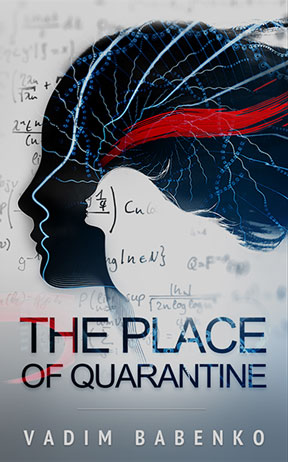Well, I stared off this week with more wondering and anxiety about our life from our burrows. How best are we to cope with the pandemic and other existential risks?
To that end, let's begin our review with an interesting sci fi novel I just picked up. I can't quite recall how I came across this novel other than it had something to do with searching for some writings on consciousness for an upcoming philosophy workshop while trying to do more work in quantum field theory. This novel, "The Place of Quarantine" by Vadim Babenko starts off with the character, Theo, finding himself in a strange place and perhaps actually dead. He has no recollection of why or where he is there. It seems he had been working on QFT and had added a new interaction term to the Lagrangian, to account for a newly proposed B-object particle, which creates the effects of consciousness, and many other people in quarantine want the benefits of this new theory and urge him to try to remember. The quarantine might have resulted when two branes, like those that some physicists believe collided to cause the big bang, have come close to contact again. Hmm, the mystery is starting to unfold and the story is getting off to a good start!
 |
| Consciousness & Lagrangians for physicist wannabes (Source: V. Babenko, "The Place of Quarantine") |
In addition to that interesting novel, some philosophy friends recommended a 2010 film, "Agora", which covers the story of Hypatia, the brilliant female astronomer associated with the Library of Alexandria, in the 4th/5th century AD. Today, we know the sun is at the center of the solar system, but in Hypatia's time, the Ptolemaic Earth centered view was in full force even though the 3rd century BC heliocentric thoughts of the Greek astronomer, Aristarchus, were known.
The film Agora depicts the heroine, Hypatia, making astronomical measurements and teaching astronomy in Alexandria at a time when the role of women as teachers was coming under attack. The film covers the then existing relationship between religion and science the role of a woman who was only allowed for a time to teach only men. The conflicts between the Romans, Pagans, Christians and Jews resulted in the destruction of the Library and Hypatia was killed by a mob, In this scene, Hypatia and her scribe are shown using a sandbox to explore what possible orbits might look like. Historically, as pointed out by Physicist, Old Ben, the Library had already been destroyed prior to Hypatia's time, but it is still a good story. It is an interesting film and we are left wondering what the state of the world today would be if the Library were not destroyed and free inquiry held in higher esteem rather than the way it happened?
 |
| Hypatia is depicted trying to resolve observations of planets motions (Source: "Agora", 2010) |
So, even today remembering some of the conflicts and threats to civilization, recall in previous posts of May 20 and June 22, respectively, we discussed the existential risks outlined in the book, "The Precipice" and finding asteroids that that might be a collision approach to Earth. Fortunately we might be able to mitigate some of these risks if we look far enough ahead and plan correctly. The issue of the current pandemic is the topic of an article in Wired magazine by van Ratliff, who tackles the issue outlined by Nathan Wolfe, about getting insurance to cover natural disasters and re-insurance to cover wider spread disasters. He explains how typical insurance plans work and how they can spread the risk over a wider number of people so that purchasing insurance is more affordable. An insurance company in one country, say, can get re-insurance from companies in widely dispersed countries as a way to average the risk down. For example, severe storm can cause a lot of damage to the affected area, but it is not likely that severe storms will cover the entire Earth at the same time, so it is possible to diversity the risk and still cover the limited number of very powerful storms that actually occur. He was busy trying to develop insurance to cover health and business interruption due to pandemics, but when if comes to a pandemic that occurs all around the world, simultaneously, then the affordability of insurance breaks down. Luckily the proposed insurance plans were never sold as they would have bankrupted any company faced with a worldwide pandemic. It is sort of the same thing when it comes to getting asteroid damage insurance. Nonetheless, it still seems the prudent thing for taking some action to deal with worldwide pandemics in the future or in countering some of the risk of an asteroid strike.
 |
| Re-insurance for worldwide events, like pandemics (Source: "Wired", Jly/Aug 2020) |
Even astronomers face smaller levels of risk just at their own observatories. Here we see the the recent fires in Arizona put the Mount Lemmon Observatory at risk, but luckily it did not suffer any damage. The fires sure got close to some of the observatory domes.
 |
| Mount Lemmon Observatory escapes fire damage (Source: U of Arizona) |
Other potential disasters can occur on the scale of galaxies too. Consider this case where our home galaxy, The Milky Way, has been observed shredding and destroying one of its dwarf satellite galaxies, Sgr dSph. This artists impression shows the dwarf galaxy still in orbit around the Milky Way, but the tidal forces are shredding all the stars in giant arcs of stars.
 |
| Artists depiction of tidal disruption of Sgr dSph by Milky Way (Source: D. Law, UCLA) |
Now, the artists impression is good enough, but have you wondered how these measurements of the tidal disruption are made. So, rather that worry about the existential risks, which are next to zero for us, lets just take a look at the details. Well, it turns out that the data from the Gaia satellite can be analyzed and the orbital position of millions of stars in the Milky Way can show which are actually Milky Way stars and which stars have been shredded from the dwarf galaxy. The authors of this paper on the arXiV show some of the data and analysis. But for me, no fault of the authors, I have a hard time seeing it in the data. Maybe you can try your eye on the data and let us know what you find. We can expect that Milky Way stars will display orbital characteristics recognizable as belong to the Milky Way, while the shredded stars of Sgr dSph will have components of velocities that show their origin as belonging to their history as part of the dwarf galaxy, even as it orbits the Milky Way.
 |
| Observed disruption of SGR dSph by Milky Way (Source: Vasiliev & Elokurov, arXiV:2006.02929) |
Now on a more positive note, there is more SpaceX Starship news coming out of Boca Chica. In the previous post of June 26, we showed some aerial photos of the launch site. We could see the remains of SN7 tank that failed during a pressure test. Here in this photo by @LadPadre we can see the ruptured tank just before the whole thing blew apart and jumped off the launch test stand. Thanks for that @LabPadre.
 |
| Starship SN7 tank suffers failure during excess pressure test (Source: @LabPadre) |
But what he have seen with SpaceX test activity that one failure does not set them back for long and design changes get incorporated very quickly. In this photo below we see two Starship prototypes in fabrication in the high bay building.
 |
| Fabrication of latest Starship prototypes in the Boca Chica highbay (Source: @Bocachicagal) |
At the same time, the SN7 Starship is transported from the assembly and fabrication facilities on one side of Highway #4, down the road a bit to the other side where the launch test site is located. Yep, now we see why Highway 4 gets closed periodically. How would you like to pass this thing on your drive down to the beach? Again, you might want to go back and look at some of the aerial photos of the sites that were posted previously for more details about the area.
 |
| Latest Starship prototype (SN5 ?) rolls down the Texas Highway 4 (Source: @LabPadre) |
So, we are are a bit bummed out about the earlier discussion of existential risk and being stuck in our burrows and not able to get back to Boca Chica, but we adjusted our coronavirus risk management plan to include another lunch out in the sunshine. Again it seems that while maintaining good physical distancing it should be low risk to include more sit down dinners outside on the patios of some favorite restaurants. Here we see Resident Astronomer seated on the patio with the lake in the background. It was quite relaxing and healing to be outside and watching the ducks and boaters enjoying themselves in their own splendid isolation. We certainly came away a bit refreshed. A tiny bit of alcohol helped too!
 |
| Resident Astronomers take time out for sanity & patio dining on the lake (Source: Palmia Observatory) |
Finally, with the latest update to iPhone apps they seem to know more about us and as they scan through our calendars and photos they take advantage and remind us of events from the past. This image of our visit to Owens Valley Radio Observatory (OVRO) from six years ago, yesterday, popped up on the screen. Darn, after a great relaxing lunch on the lake, here is something more to worry about the little phone that we carry around with us at all times. I might, and maybe we all should look at what permission settings we have on all of our favorite apps, but this time, we were reminded of a happier trip in the past. Has it really been six years since we were there for a tour and some night sky viewing and imaging with an 8-inch Celestron? How we would like to be able to get out and about now like we were able to do back then!
 |
| Blast from the past -- Owens Valley Radio Observatory in June 2014 (Source: Palmia Observatory) |
Until next time, here from our burrow, stay safe, as we recover more of our freedom,
Resident Astronomer George
Be sure to check out over 400 other blog posts on similar topics
If you are interested in things astronomical or in astrophysics and cosmology
Check out this blog at www.palmiaobservatory.com

No comments:
Post a Comment